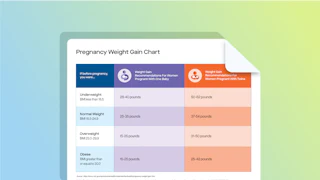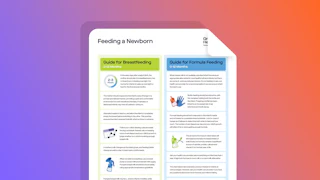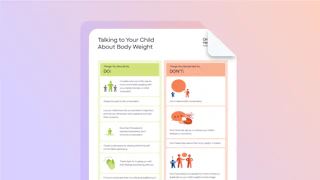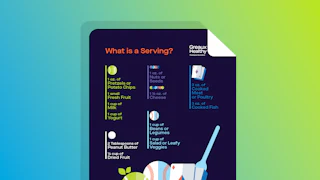Unsure of what a healthy pregnancy looks like for you? Every mom is different! Click the PDF to see the CDC’s pregnancy weight gain recommendations.
Expectant Parents, Families & Caregivers
Expectant mothers Healthy pregnancy & weight gain
Before parents conceive, they are already influencing their child’s health. If parents carry extra weight or have obesity when they conceive, their child is at a higher risk of developing childhood obesity.4

Getting a healthy head start
How much weight moms gain during pregnancy matters! Studies tell us that gaining weight early on is linked to childhood obesity.5 The good news is, if expectant moms focus on their own health and follow gestational weight gain guidelines, they can give their children a healthy start in life.


Infant and child nutrition
Obesity is affecting more kids than ever, including babies under the age of two. In the past, parents were told that their babies would “grow into their weight” or naturally slim down as they got older. Now, we understand that if babies or toddlers have too much weight, they’re more likely to have obesity as they grow up.6,7
Feeding babies is often not just about nutrition. Sometimes it’s done to soothe them or help them sleep. As a result, babies are often getting more to eat than they need, which can affect their health right from the start. Overfeeding babies can have not only unintended effects like stomach discomfort, it can also impact a child’s future weight.8
Early food and drink choices are important to help establish healthy food preferences while also providing age-appropriate nutrition for developing bodies and brains. Knowing what foods your child needs and in what amount to support a healthy weight and development can be tricky. Use these resources to help guide you:
CDC Newborn Feeding Guide
Curious about how much your baby should be eating? Click the PDF for the CDC’s formula and breastmilk infant feeding recommendations.
Starting the conversation
Talking to your child or doctor about weight concerns can be hard. It’s a sensitive topic and one that can be difficult to approach, but these conversations are necessary. Your child needs a support system. For parents who are concerned about their child’s health and the difficulties they may be experiencing such as bullying or negative body image, there are many valuable resources available to help start a healthy conversation about your child’s body. Read more about the Top 3 Questions that Parents ask a Pediatric Obesity Specialist and what you can do to effectively support your child's health.

Check out the PDF for a few things to remember when discussing weight-related concerns with your child.

Modeling healthy habits
Lifestyle habits are formed during childhood
Did you know that many lifestyle habits are formed during childhood? Even individual taste preferences are set by the age of five. Kids are greatly influenced by their surroundings, making the habits and behaviors they see at home very important.
Good role model habits make a difference
Studies show that kids are more likely to be active and choose nutritious foods like fruits and vegetables when their parents, guardians, or other household members encourage exercise and healthy eating habits.9 In fact, the chances of successfully adopting healthy habits and making lifestyle changes increase a lot when the whole family gets involved. Being an active and healthy role model, you’re not only helping yourself but also setting your kids up for a healthy, successful future. Keep up the healthy habits!
Making healthy eating easy
Balanced, nutritious meals and snacks are key to a healthy life; however, they often come with a few roadblocks. Overcoming cravings for less nutritious snack foods, figuring out how and where to shop for healthy options, and getting your family members on board with healthy eating can be challenging. Click on any of the topics below for helpful tips and information to keep your nutrition on track!
To prepare healthy meals and have nutritious foods on hand you need to grocery shop with a plan. Which foods are nutritious? How much do you need to buy? Grocery shopping can be overwhelming! Here are some easy ways to help eliminate most of the guesswork:
Before You Go
- Always make a list!
- Look in your pantry and fridge to see what you have on hand already.
- Find 3-4 nutritious recipes to cook for the week and make enough to have leftovers to eat during the week or freeze to eat the following month. (Check out “Recipes” below for helpful resources in finding and planning nutritional meals).
- Find nutritious recipes for quick meals and snacks, and aim to keep those ingredients stocked at home.
- Keep record of which nutritional foods and recipes your family likes best, so you can easily access them and prepare them again in the future.
- Eat a nutritious meal or snack before going to the grocery store, so you don’t shop on an empty stomach. This will help you avoid impulse purchases and stick to your healthy list!
- Get your family involved in planning recipes and creating the list. Children are more likely to try and enjoy foods they’ve helped select and/or prepare.
- Make sure your list includes plenty of fresh, frozen, or canned fruits and vegetables. Remember, the fresher the better!
- If you choose canned vegetables, rinse them before eating to lower the added salt.
- If you choose canned fruit, choose fruit in 100% juice and rinse before eating to lower the sugar content.
At the Store
- Bring your list with you and stick to it!
- Bring a nutritious snack with you if needed to avoid buying snack foods not on your list.
- Park as far from the grocery store as possible to increase physical activity.
- If possible, shop the outer aisles in the grocery store to find fresh and healthy foods. Those extra steps around the store can help increase physical activity, too!
- Check out the “How to Read a Food Label” resource on this page and use it to compare foods and make the healthiest selections.
In addition to grocery stores, many communities have farmers’ markets or community gardens where residents can access nutritious, locally sourced foods. To learn more about farmers markets or to find the nearest one to your community, check out these resources:
Use the How to Read a Nutrition Facts Label PDF to help you better understand the foods you eat!
For additional grocery shopping tips, visit these resources:
You don’t have to be a master chef to prepare nutritious meals. These resources will provide you with a variety of healthy meals that can fit any budget, skill level, and dietary needs:
Pennington Biomedical Metabolic Kitchen
National Heart, Lung, and Blood Institute
Planning ahead for meals and snacks takes the guesswork out of healthy eating. With some planning effort you can ensure that you meet your nutritional needs within your budget and busy schedule. You can even make the most of the ingredients you have on hand! Check out these useful meal planning resources for help:
Of all the challenges that come with getting your family to eat healthy, picky eating could be among the most difficult. It can feel impossible to make changes when your child will only eat a handful of foods. Even though it may present a challenge, there are still ways to help get even the pickiest of eaters on board. Check out the “Healthy Tips for Picky Eaters” resource to learn how!
Download this PDF for tips on dealing with picky eating, getting kids to try new foods, and helping kids develop healthy eating habits.
While “supersized” meals are common at fast food restaurants, the fact is that portion sizes have increased everywhere over the past several decades.10 Americans aren’t just eating more at restaurants. We’re eating more at home too, which makes maintaining a balanced diet difficult. Understanding serving sizes and appropriate portions of different types of foods can help you make sure you aren’t giving your body too much or too little, but just enough of what it needs.
Check out the “What is a Serving?” resource, or visit these websites for more helpful portion control tips:
National Heart, Lung, and Blood Institute
Learn more about how serving sizes from each food group compare to everyday items.
Discovering that some of your favorite everyday food choices aren’t very healthy can be disappointing. When cravings for things like sugar strike, it can make healthy eating seem impossible. Fortunately, there are lots of simple changes you can make that allow you to still prepare delicious foods, satisfy your cravings, and stay on track with your healthy eating habits! For instance:
- Instead of regular soda, choose a sugar-free option or sparkling water. Almost half of the added sugars in our diets come from drinks!
- Instead of flavored, full-fat yogurt, try a plain, low-fat option.
- Buy low sodium versions of canned vegetables and other food staples.
- Replace butter with olive oil in your cooking.
- Instead of candy, eat fruit to help satisfy your sweet tooth.
While the best way to control what you eat is by preparing your own meals, it is also important to know how you can make healthy choices when eating out, too. Here are a few tips to help you make the healthiest possible choices when eating at a dine-in restaurant, fast food restaurant, or cafeteria:
Try
- Salads, fruit, or veggies as your side dish
- Veggie toppings like lettuce, tomato, and onions
- Ketchup and mustard sauces
- Water, low-fat milk, or 100% juice
- Single patty hamburgers
- Grilled, broiled, or baked meats and poultry
- Low-fat or fat-free dressings
- Ordering from the children’s menu for smaller portion sizes
Avoid
- Anything large, double, jumbo, or super-sized
- French fries or onion rings as a side dish
- Mayo, creamy sauces, oils, and spreads
- Sugary soft drinks
- Anything “crispy” or fried
- Cheese, bacon, and croutons as toppings
- Creamy salad dressings

Age-appropriate physical activity
Making sure children are physically active is important for their lifelong health and wellness and prevention of obesity. For kids to be active, they need to know how to move their bodies for their age and in developmentally appropriate ways. It all starts from a baby’s very earliest days, as they get stronger and begin to develop important motor skills. As kids continue to grow, the importance of physical activity does, too. School-aged children should be getting a full hour of moderate-to-vigorous activity every day.
Getting kids moving isn’t just about preventing obesity—it's about making stronger bones, muscles and hearts; and establishing healthy habits that last a lifetime. Physical activity doesn’t just benefit bodies either. It’s good for the mind too, helping kids concentrate better and reduce stress.
Encourage activities that your child enjoys, making exercise a fun part of their daily routine.
Click on the PDF for some ideas to easily start increasing your physical activity with lifestyle changes you can do every day!

Taking charge of screen time
Today’s children have access to screens like never before. Not only are their devices used for entertainment, but for socialization and learning as well. As useful as phones and tablets can be, we know that too much time in front of them comes with some negative side effects. Too much screen time can disrupt children’s sleep patterns,11 leading to fatigue and even affecting their performance at school. Additionally, more screen time means less time for physical activities, which are important for keeping kids’ muscles strong and preventing health issues like obesity.
As parents and caregivers, it is important to encourage a healthy balance between screen time and other activities. It’s not about restricting fun but making sure your child’s health remains a top priority.
Continue learning
Citations
- Food, Beverages, and Obesity in Children and Adolescents. Jakobsen DD, Brader L, Bruun JM. Association between Food, Beverages and Overweight/Obesity in Children and Adolescents-A Systematic Review and Meta-Analysis of Observational Studies. Nutrients. 2023;15(3):764. Published 2023 Feb 2. doi:10.3390/nu15030764
- Access to Fruit and Vegetable Markets and Childhood Obesity. Yang S, Zhang X, Feng P, et al. Access to fruit and vegetable markets and childhood obesity: A systematic review. Obes Rev. 2021;22 Suppl 1(Suppl 1):e12980. doi:10.1111/obr.12980
- Screen Media Exposure and Obesity in Children and Adolescents. Robinson TN, Banda JA, Hale L, et al. Screen Media Exposure and Obesity in Children and Adolescents. Pediatrics. 2017;140(Suppl 2):S97-S101. doi:10.1542/peds.2016-1758K
- Effect of Maternal Weight on Children. Heslehurst N, Vieira R, Akhter Z, et al. The association between maternal body mass index and child obesity: A systematic review and meta-analysis. PLoS Med. 2019;16:e1002817. doi: 10.1371/journal.pmed.1002817
- Early pregnancy weight gain exerts the strongest effect on birth weight, posing a critical time to prevent childhood obesity - PMC. Broskey NT, Wang P, Li N, Leng J, Li W, Wang L, Gilmore LA, Hu G, Redman LM. Early pregnancy weight gain exerts the strongest effect on birth weight, posing a critical time to prevent childhood obesity. Obesity (Silver Spring). 2017;25(9):1569-1576. doi:10.1002/oby.21878 (bold indicates PBRC)
- Predicting obesity in young adulthood from childhood and parental obesity - PubMed. Whitaker RC, Wright JA, Pepe MS, Seidel KD, Dietz WH. Predicting obesity in young adulthood from childhood and parental obesity. N Engl J Med. 1997;337(13):869-873. doi:10.1056/NEJM199709253371301
- Predicting adult obesity from childhood obesity: a systematic review and meta-analysis. Simmonds M, Llewellyn A, Owen CG, Woolacott N. Predicting adult obesity from childhood obesity: a systematic review and meta-analysis. Obes Rev. 2016;17(2):95-107. doi:10.1111/obr.12334
- Newborn feeding recommendations and practices increase the risk of development of overweight and obesity. Watchmaker B, Boyd B, Dugas LR. Newborn feeding recommendations and practices increase the risk of development of overweight and obesity. BMC Pediatr. 2020;20(1):104. doi:10.1186/s12887-020-1982-9
- Factors Influencing Children's Eating Behaviours. Scaglioni S, De Cosmi V, Ciappolino V, Parazzini F, Brambilla P, Agostoni C. Factors influencing children's eating behaviours. Nutrients. 2018;10(6):706. doi:10.3390/nu10060706
- Yes, Food Portion Sizes and People Have Become Bigger and Bigger. What Is to Be Done? | AJPH | Vol. 111 Issue 12. Monteiro CA, Cannon G. Yes, food portion sizes and people have become bigger and bigger. What is to be done?. Am J Public Health. 2021;111(12):2091-2093. doi:10.2105/AJPH.2021.306547
- Screen Time and Sleep among School-Aged Children and Adolescents. Hale L, Guan S. Screen time and sleep among school-aged children and adolescents: a systematic literature review. Sleep Med Rev. 2015;21:50-58. doi:10.1016/j.smrv.2014.07.007
- https://www.healthychildren.org/English/family-life/Media/Pages/healthy-digital-media-use-habits-for-babies-toddlers-preschoolers.aspx Beyond screen time: Help your kids build healthy media use habits. (n.d.). HealthyChildren.org. https://www.healthychildren.org/English/family-life/Media/Pages/healthy-digital-media-use-habits-for-babies-toddlers-preschoolers.aspx






